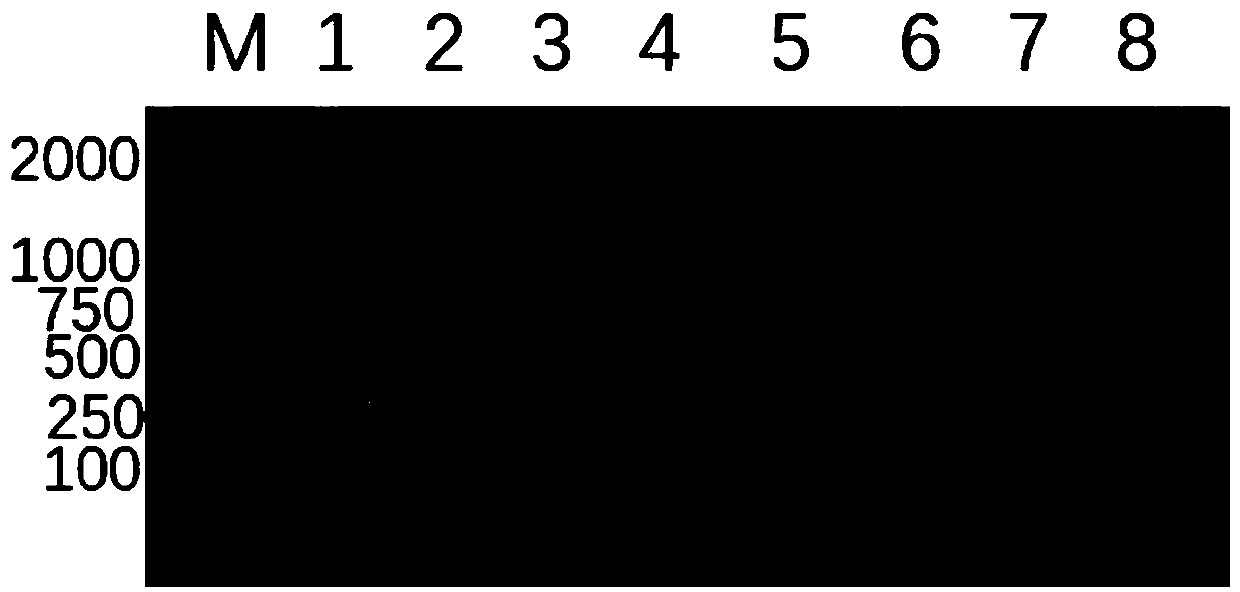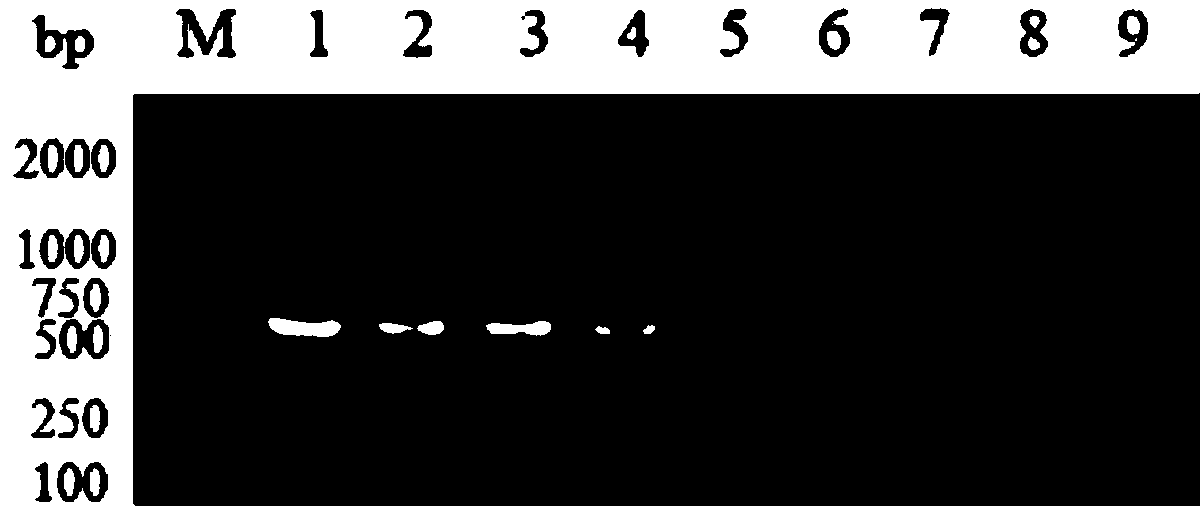Universal type porcine deltacoronavirus nested RT-PCR detection method
A technology of RT-PCR and coronavirus, which is applied in the direction of microbe-based methods, biochemical equipment and methods, microbiological measurement/testing, etc., can solve the problem of low sensitivity of RT-PCR, and achieve strong specificity and practicability Strong, reliability-enhancing effect
- Summary
- Abstract
- Description
- Claims
- Application Information
AI Technical Summary
Problems solved by technology
Method used
Image
Examples
Embodiment 1
[0029] Example 1: Establishment of porcine D-coronavirus nested RT-PCR detection method
[0030] (1) Design of porcine D-coronavirus nested RT-PCR primers
[0031] Design two pairs of specific primers according to the base sequence in the porcine D-coronavirus N gene, the sequences of the two pairs of primers are respectively:
[0032] PDCoV-O-F: 5'-CAGGTCCCAGAGGAAATCTTA-3' (SEQ ID NO.1)
[0033]PDCoV-O-R: 5'-TTTGGTAGGTGGCTCATAGGT-3' (SEQ ID NO.2);
[0034] PDCoV-I-F: 5'-GAAGACCTCAGGAGCGTGGAA-3' (SEQ ID NO.3);
[0035] PDCoV-I-R: 5'-TGAGTAGGAGAAGGTAAGGGTGA-3' (SEQ ID NO. 4).
[0036] (2) Sampling and RNA extraction
[0037] A: Sample collection: Collect sample serum, centrifuge at 3000r / min for 20 minutes, take 200μL to extract RNA with Trizol RNA extraction solution, and measure the concentration for later use.
[0038] B: Tissue sample processing: Take the liver and lung of the pig samples to be tested, shred them, extract RNA with Trizol RNA extraction solution, and me...
Embodiment 2
[0044] Example 2: Construction of recombinant positive plasmid pMD18-T-N
[0046] Genomic RNA of porcine D-coronavirus (PEDV) was extracted, using the genomic RNA as a template, using nested RT-PCR outer primers PDCoV-O-F and PDCoV-O-R to amplify part of the conserved sequence of the N gene. The PCR reaction system (25 μl) is: 12.5 μl of 2×1 Step Buffer, 1 μl of PrimeScript 1Step Enzyme Mix, 1 μl each of 20 μmol / L PDCoV-O-F and 20 μmol / L PDCoV-O-R, 1 μl of RNA template, and RNase Free dH 2 O to 25 μl; PCR reaction program: reverse transcription at 50°C for 30 min, pre-denaturation at 94°C for 2 min, denaturation at 94°C for 30 s, annealing at 55°C for 30 s, extension at 72°C for 45 s, 32 cycles, and extension at 72°C for 6 min. % of the agarose gel for electrophoresis identification, the results are as follows figure 1 As shown, a specific DNA band of about 665 bp was obtained, which was consistent with the size of the target DNA fragment.
[...
Embodiment 3
[0053] Embodiment 3: Nested RT-PCR primer characteristic detection
[0054] (1) Specificity test: extract porcine reproductive and respiratory syndrome (PRRSV), porcine transmissible gastroenteritis virus (TGEV), porcine rotavirus (PoRV), porcine pseudorabies virus (PRV), Escherichia coli and golden yellow The Staphylococcus genome was used as a template to detect the specificity of the two pairs of primers PDCoV-O-F, PDCoV-O-R, PDCoV-I-F, and PDCoV-I-R used in nested RT-PCR, and the specificity of the two pairs of primers was tested. The results are as follows: figure 1 , as shown in 2, both pairs of primers have good specificity and high amplification efficiency.
[0055] (2) Sensitivity test: The positive plasmid obtained in Example 2 was diluted 10-fold to single-digit copy number, and the plasmids of each dilution were selected as templates for the first PCR with primers PDCoV-O-F and PDCoV-O-R Amplify, PCR product detects with 1% agarose gel, the result is as follows ...
PUM
 Login to View More
Login to View More Abstract
Description
Claims
Application Information
 Login to View More
Login to View More - R&D
- Intellectual Property
- Life Sciences
- Materials
- Tech Scout
- Unparalleled Data Quality
- Higher Quality Content
- 60% Fewer Hallucinations
Browse by: Latest US Patents, China's latest patents, Technical Efficacy Thesaurus, Application Domain, Technology Topic, Popular Technical Reports.
© 2025 PatSnap. All rights reserved.Legal|Privacy policy|Modern Slavery Act Transparency Statement|Sitemap|About US| Contact US: help@patsnap.com



